|
|
McLaren MP4-12C
|
 |
|
|
Debut: 2011
Maker: McLaren
Predecessor:
No
|
|
|
|
Published
on 20
Jul 2011
|
All rights reserved.
|
|
|
In the Formula One
world,
only one name can rival Ferrari: McLaren. Since Ron Dennis and John
Barnard's Project Four took over McLaren in the early 1980s, the team
produced 10 driver championships – one for Niki Lauda, three for Alain
Prost, three for Ayrton Senna, two for Mika Hakkinen and one for Lewis
Hamilton. All their race cars carried the name MP4, an acronym for
McLaren Project Four. Today, McLaren wants to challenge Ferrari in the
road car world with another MP4. The MP4-12C signals the relaunch of
McLaren Automotive as a sports car manufacturer. Previously, the
company was renowned for making the mighty McLaren F1 and then (the
less successful) Mercedes SLR. Both were ultra-expensive supercars, but
they hardly made any money. This time around, McLaren is determined to
make a business case. Ron Dennis left the F1 team and took over the
responsibility for the road car division. A new assembly plant is being
built at Woking for the production of MP4-12C, whose price of
£170,000 allows it to take on Ferrari 458 and Lamborghini
Gallardo (as well as some serious 911s and Astons) in a broader market
segment. Its sales volume is projected to 1500 cars a year, a
day-and-night difference to the 100 F1s and 2153 SLRs produced over
their entire life cycles. In addition to other variants and siblings to
come in the future, McLaren is anticipated to produce 4,000 cars a
year, which should make it a solid rival to Ferrari, Lambo and Aston.
Given the glorious track record of the Gordon Murray-designed F1, our
expectation on the MP4-12C is inevitably high. The new car might be
less groundbreaking than the old car – after all, its more affordable
price does not allow the strive-for-excellence-at-any-costs approach of
Gordon Murray – but it does not disappoint. It introduces many firsts
for the class: the first carbon-fiber chassis, the first hydraulic
interconnected adaptive suspension and the first air brake for the
class. Moreover, its performance is nearly as astonishing as the F1.
With a top speed of 205 mph, 0-60 and 0-124 mph sprint taking just 3.0
and
8.9 seconds respectively, it is significantly faster than the car it
needs to beat: Ferrari 458. Our only question is: can its on-paper
superiority be translated to the real world ? We'll find out soon.
Design, Body
and
Aerodynamics
The
MP4-12C is designed by an unlikely guy, Frank Stephenson. I used
to respect Stephenson a lot as he designed two of the best modern
classics,
Mini and Fiat 500. Although he also involved Ferrari F430, 599GTB and
Maserati GranTurismo during his stint at Ferrari, we will never know
how much he contributed to the otherwise Pininfarina designs. This
McLaren is probably his first attempt to design a sports car from
scratch.
From some angles, the MP4-12C looks quite handsome. It looks fast,
adequately advanced and obviously mid-engined. Nevertheless, the same
descriptions can be applied to just any of its competitors – well, with
the exception of Noble M600 perhaps. Judging by the high standards of
supercars, its design is a little tamed, a little too ordinary. Ferrari
458 gives us a strong visual impact thanks to its sexy curves and
aggressive features. Lamborghini Gallardo delivers a sense of brutal
power and uncompromising character. The McLaren has none of them. It's
not even a gentleman sportscar like Aston V12 Vantage or the Duke of
SLS AMG. In particular, character is strangely missing here. It doesn't
share any visual genes with the famous F1. That could be a big mistake.
On the
contrary, it has quite a lot of similarity with the late Ascari KZ1, which puzzles me.
From some angles, the MP4-12C could look a little bulky – the nose is
not slim enough, the whale mouth a little clumsy, the inward-facing
eyes lack sparkles, the A-pillars
too thick, the waist line appears too high, the side air scoops
oversized and the butt too big. The back looks much better though. Its
LED taillights and
twin-exhaust are hidden in the black grille like no others. Less unique
is the back window which lets us have a full view on the engine. This
arrangement
looks cool, especially when it is surrounded by hot air outlets to
deliver a sense of exoticness. A pity the rest of the car does not look
as exotic.
If you inspect these photos closely, you may find the body shell does
not look as high quality as it should. Panels are generally thicker
than what need to look elegant, while assembly gaps are wider than
class norm. This is because the majority of body shell is constructed
from SMC (Sheet Molding Compound), or in other words, glass-fiber
composites. Only the small front fenders, front bonnet and roof are
made of stamped aluminum. Glass-fiber is lighter than aluminum, but it
does not achieve the same tight tolerance as aluminum. That's why for
the sake of visual quality Ferrari and Aston Martin still employ
aluminum for the majority of their body shells. McLaren chose the
otherwise priority.
Like many modern supercars, its shape is dictated by the needs for
aerodynamics and cooling. Those XXL side air scoops are designed to
cool the main radiators, which are mounted close to the engine to cut
piping and coolant weight. The much smaller intakes at the nose are
responsible for cooling the intercoolers of turbochargers. Such
arrangement is very different to the cases of Ferrari 458 and
Lamborghini Gallardo, both have their radiators mounted at the nose,
thus require larger front intakes and smaller side intakes.
McLaren did not reveal any aerodynamic figures. Judging from its
performance figures (205 mph from 600 hp), which is close to those of
Ferrari 458 (202 mph from 570 hp), its aerodynamic drag should be more
or less the same as the 0.33 of Ferrari. Unlike Ferrari, however, its
aerodynamic design seem to be pretty conventional. A large part of
downforce is contributed by the movable rear wing, which raises up to
32 degrees at speed. During braking, it doubles as "Air Brake" by
lifting to 69 degrees, blocking air and helps slowing down the car. You
might remember the Air Brake was pioneered by McLaren F1 and has been
used in SLR as well. Now it becomes a signature of McLaren.
 Air
Brake is the signature of McLaren
Air
Brake is the signature of McLaren
While its Ferrari and Lamborghini rivals employ aluminum spaceframe
chassis, the McLaren has a more advanced carbon-fiber tub - after all,
the maker of F1 and SLR has never manufactured a metal chassis. Called
MonoCell, the carbon-fiber tub is made in one piece through RTM (Resin
Transfer Molding) process, unlike conventional carbon-fiber chassis
which are made in dozens of components bonded together. This saves
manufacturing time and cost significantly. McLaren said it takes only 4
hours to build, versus 300 hours on the previous SLR and 4000 hours on
the F1 ! As a result, production cost is slashed to about US$10,000,
making the technology possible for this class for the first time.
The carbon-fiber tub provides direct mounting for the double-wishbone
front suspensions. At the back, an aluminum engine subrame supports the
powertrain and double-wishbones rear suspensions in order to filter NVH
from the cockpit. Aluminum subframe is also presence up front, but it
is used to provide crumple zone. For cost reasons, MP4-12C abandons the
carbon-fiber crash structure pioneered by SLR. The windscreen pillars
are made of aluminum casting and reinforced with baron steel tubes. All
these show that McLaren has learned from errors in the past. Now it
uses
expensive technologies only at areas where matter most.
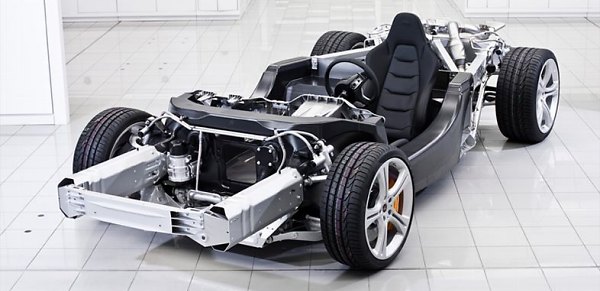 Carbon-fiber
tub is the first in the class
Carbon-fiber
tub is the first in the class
The MonoCell weighs less than 80 kilograms. It's not the only weight
saving measure though. Others include a magnesium dashboard structure,
magnesium seat frames, lightweight lithium-ion battery, aluminum
electrical wires (saves 5 kg over copper ones) and AP
cast-iron-aluminum
disc brakes (whose aluminum hubs save 2 kg per corner, making it
actually lighter than the optional ceramic discs). Overall, the car is
a good 50 kg lighter than Ferrari 458.
A further 35 kg can be saved by ticking the lightweight option, which
includes lightweight wheels (save 2.5 kg each corner), Recaro
carbon-fiber seats, carbon-fiber splitter and diffuser, lightweight
Inconel alloy exhaust and Brembo ceramic brakes. Besides, the package
comes
together with semi-racing Pirelli P Zero Corsa tires.
The MP4-12C has a front-to-rear weight distribution of 42.5:57.5, half
a percentage point better than Ferrari 458. It also claims better polar
moment of inertia and chassis rigidity.
Engine and Gearbox
McLaren has never built its own engines, no matter for race cars or
road cars. For the MP4-12C, it commissioned British engineering
consultant Ricardo to develop a 3799 cc twin-turbo V8 capable of
producing 600 horsepower and 442 pound-foot of torque. Rumors said it
was derived from a Nissan endurance racing motor. If so, its ties with
the latter must be very loose. This engine not only complies with all
known emission regulations, it is also arguably the "greenest"
high-performance motor. Emitting only 279 grams of carbon-dioxide each
kilometer in EU test mode, it is considerably greener than Ferrari
458's
naturally aspirated V8 (at 320 g/km) or just any rivals. McLaren claims
it delivers the highest horsepower-to-emission ratio in the world.
The V8, codenamed M838T (which obviously means McLaren, 8 cylinders,
3.8-liter and Turbo), is compact and lightweight. Predictably, it runs
dry-sump lubrication to enable a lower center of gravity. Weight is
kept to the minimum by using flat-plane crankshaft (like Ferrari V8s)
and thermoplastic to construct the cam covers and intake manifolds. Two
Mitsubishi turbochargers provide a maximum boost pressure of 1.2 bar.
The 32 valves are controlled by variable cam phasing. The only critical
technology missing here is direct fuel injection, though it seems to
hurt little its emission.
Torque curve shows the engine is highly flexible. Max. torque is
available from 3000 to 7000 rpm, while 80 percent of which arrives as
early as 2000 rpm.
On the other hand, the engine can rev to as high as 8500 rpm, just 500
rpm shy of Ferrari, which is undeniably impressive for a turbocharged
engine. This must thanks to its low-inertia flat crankshaft, seriously
oversquared combustion chambers (93 mm bore x 69.9 mm stroke) and
Nikasil cylinder coating.
Mounted right behind the V8 is a 7-speed twin-clutch gearbox dubbed
"Seamless Shift Gearbox" (SSG). Although Ricardo has long developed one
for Bugatti Veyron, the one mated with the Ricardo V8 is supplied by
Italian gearbox expert Graziano, which finally joins Getrag and ZF to
the party of twin-clutch. Like Ferrari, the software and controls are
developed in-house. The McLaren follows its formula one practice to
employ a single gearshift paddle, which carries out upshift and
downshift by pulling or pushing the paddle. Besides, it enables the
driver to preselect the next gear by half-pressing the paddle, just
like half-pressing the shutter button on a camera to carry out
focusing. Therefore, once the paddle is fully pressed, the next gear
can be actuated instantly. McLaren calls this feature "Pre-cog".
Suspensions and
Electronic
Aids
The all-round double-wishbones suspension employs coil springs and
forged aluminum control arms. What makes it unusual is the lack of
anti-roll bars and conventional dampers. In place of them is a
computer-controlled hydraulic suspension system that McLaren called PCC, or Proactive
Chassis Control. It uses a twin-chamber cylinder at
each corner. The cylinders are interconnected front and rear, left and
right hydraulically. Two gas-filled accumulators connected to the
hydraulic circuits actuate the resistance to body roll, while
adjustable valves at each cylinder alter the rate of oil flow hence
damping rate. Consequently, the PCC offers the function of adaptive
damping as well as active anti-roll. Because it saves the need for
anti-roll bars, ride comfort could be greatly improved on rough
surfaces. On the other hand, the active anti-roll allows MP4-12C to
offer the best body control and roadholding in the class. Ron Dennis
even describes it "the best handling sports car in history" !
The hardware of PCC is supplied American component maker Tenneco. Its
theory can be found in AutoZine
Technical School.
 Ron
Dennis: the best handling sports car in history !
Ron
Dennis: the best handling sports car in history !
Like most performance cars these days, the McLaren offers a
driver-selectable dynamic control system. On the center console there
are two rotary switches, one marked with "P", which controls
Powertrain, and another marked with "H", which controls Handling. Both
of them offer 3 modes – Normal, Sport and Track. It goes without saying
that the Sport modes activate faster engine and gearshift response,
louder exhaust note, firmer PCC suspension setting, weightier power
steering and higher threshold for the stability control, while the
Track modes are hotter still.
Nevertheless, the McLaren's handling design is not all that superior.
Its Achilles' heel is the lack of a limited slip differential. Yes, it
might be strange to hear that on a car at this performance level.
Instead of LSD, McLaren applies its ex-F1 technology, Brake Steer, to
control the car's cornering attitude. In case of understeer, the system
soft-brakes the inside rear wheel, shifting more power to the outside
rear wheel thus counteracting the understeer. So what is the difference
from the torque vectoring that you can find in, say, a Volkswagen Polo
? Actually, there is no difference except the software. We believe with
McLaren's wealth of experience in testing and simulations it is able to
write better software, but so can Ferrari and Porsche. The fact that
those rivals still employ active LSD may imply the torque vectoring
technology is still no replacement to a good active differential.
In the Car
Like F1, the MP4-12C employs "butterfly doors" which open upward and
outward. They are not very user-friendly though. First timers may be
embarrassed to find no door handles. Instead, you run your hand over a
sensor located under the door lip to release the electric door lock.
Lift the lightweight door and a dark cabin is revealed.
Like the F1 again, the cabin is trimmed with black Alcantara and
carbon-fiber, very different to the leather-and-alloy approach of
Ferrari. The seating layout is conventional, rather than the F1's
central driving seat plus two offset passenger seats, as McLaren wants
to make it easier to access. Nevertheless, with a wide sill of the
MonoCell to overcome, it will never be as easy to access as rivals. The
wide sills also rob a lot of space, so the two seats are pushed towards
the center of the car, thus you are more likely to rub shoulders with
your passenger. On the positive side, the cabin offers plenty of
headroom, and visibility over the road in front is excellent.
The cabin is a little lacking visual drama. This is not helped by a
Volvo-style floating console on which a narrow touch-screen is mounted.
Fit and finish is generally not bad, but the details could be more
expensive to match its price. The "H" and "P" rotary switches should
have been made in metal instead of plastic. The steering wheel looks
quite aftermarket.
In-cabin storage is close to zero. The tiny space behind the seats is
nearly useless, so any luggage has to be stored in the front luggage
compartment, whose size is not at all generous.
On the Road
The performance of MP4-12C can be described as mind-blowing. It beats
anything in the class in standing-start acceleration, Ferrari 458 and
Porsche GT2 RS included. (Note: the mediocre test results by Autocar
shown below were conducted on a showery day. Even so, they were already
a match to its rivals') With lightweight options and Pirelli P-Zero
Corsa rubbers, the car is claimed to sprint from zero to 124 mph (200
km/h) in only 8.9 seconds, 1.5 seconds quicker than Ferrari and half a
second quicker than GT2 RS.
The twin-turbo V8 is very strong and flexible,
delivering meaningful thrust from as early as 1500 rpm. From 3000 to
8500 rpm cut-out, the car really flies. Thanks to a quick-shifting
dual-clutch gearbox and a good traction control, the McLaren takes off
with minimal drama. Speed is built up quickly and smoothly. Such an
accessible performance is more in the school of Bugatti Veyron than the
old McLaren F1.
How does it sound ? If you have heard about it in videos, you may be
disappointed. Yes, the exhaust noise can be very loud, especially when
the engine revs hard in Track mode (where a dedicated tube inducts
noise from the intake plenum to the cabin), but that noise is not to be
confused with music. It
just tells you it is working hard, without ever trying to touch your
soul.
 The
McLaren serves the dual-task of supercar and GT, more so than Audi R8.
The
McLaren serves the dual-task of supercar and GT, more so than Audi R8.
In isolation, the Graziano transmission is excellent. It shifts
smoothly and responsively. Although it doesn't blip throttle on
downshift to match rev as good as in Ferrari 458, we can
understand that a turbocharged engine is difficult to blip throttle as
quick as a naturally aspirated one. What ruins the driving experience
is the user interface – McLaren's single shift paddle is not only
unintuitive, but it is stiff and requires absurd effort to trigger,
blame to the need to differentiate the "Pre-cog" action and actual
gearshift. Lewis Hamilton and Jenson Button might feel okay, but road
users will find otherwise.
The carbon-ceramic brakes also left something to be desired. Although
they offer fade-free performance, the brake pedal is flawed. There is
some dead travel initially. Once overcome, the brake works like a
switch, which means very difficult to modulate the amount of braking
force. The ceramic brakes are also noisy. It is better to stick with
the standard steel brakes.
However, these flaws become nothing when you experience the McLaren's
amazing ground-covering ability. Its hydraulic suspension system is a
work of wonder. In Normal mode, it lets the car to ride as supple as a
Mercedes E-class, let it be cruising on motorway or riding on a bumpy
B-road. Even in Sport mode, it rides much better on rough surfaces than
rivals in their most comfortable settings. As a result, you can go
cross-country at enormous speed without feeling scared or tired.
Attacking corners, the hydraulic suspension keeps the car rock steady.
Roll, pitch and
dive are nearly non-existent. It feels planted on road as if on rails.
Consequently, it generates more grip and you can carry bigger speed
into corners than rivals. We have never seen a car combining such a
great handling and ride comfort. The McLaren serves the dual-task of
supercar
and grand tourer, more so than Audi R8 !
But the Proactive Chassis Control system is not by all means brilliant.
Sometimes it could be fooled by a sudden bump on a smooth road, and the
ride becomes unsettled and noisy for a while. Oddly, we found the same
problem on the previous hydraulic suspensions of Citroen.

The
biggest problem
is the presence of Ferrari 458...
Perhaps the biggest problem
of the MP4-12C is the presence of Ferrari 458. When the McLaren was
being developed, it was benchmarked against 430 Scuderia. That target
was well accomplished, but I guess McLaren had never thought the
succeeding Ferrari could take a leap so huge. Although MP4-12C still
sees victories in performance, ride and roadholding, it is shattered
by the Ferrari in almost every subjective aspect – its slight turbo lag
contrasts to the Ferrari's instantaneous throttle response; its
exhaust note is un-special beside the Ferrari's; its steering isn't as
quick and communicative; its isolated ride sometimes makes you feel
detached from the road; its brake and gearshift interfaces are far less
incisive than Ferrari's; its look doesn't stir your soul like the 458.
In short, it lacks the emotion and sensation you can find in the
Ferrari.
On an unfamiliar road, the McLaren is unquestionably faster than the
Ferrari. On a track, the balance may tip to the other side. As
CAR magazine found out in its group test, the Ferrari outpaced the
McLaren in Rockingham circuit. Evo magazine had a similar finding in
Bedford Autodrome. The McLaren's lap times were hampered by the slight
turbo lag, difficult brake and the lack of flexibility in its handling,
all combined to prevent a precise control of driving line, therefore
failing to translate the superior power and torque to faster lap times.
As we have
suspected, its Brake Steer is no replacement to a good active limited
slip differential. Sometimes it could ruin the handling by
applying correction at the wrong time and magnitude, so when you apply
a quick opposite lock to induce oversteer, it might end up swapping its
ends. No wonder Autocar, a keen
supporter of the British marque, described in its full test report that
the McLaren needs the driver "to do things its ways, not yours", and it
cries for "more flexibility in the way it allows its driver to attack a
corner".
So Ron Dennis' claim of "the best handling sports car in history" is
somewhat overstated. We have no doubt about its speed and cross-country
ability. It may be the fastest A-to-B car, and probably the only super
sports car that serves the role of grand tourer equally well. All
these merits should make the MP4-12C a five-star car, but it just can't
match the very best Ferrari. |
Verdict:      |
| Published
on 22
Oct
2012 |
All rights reserved.
|
|
MP4-12C Spider
|
|
The experience of Ferrari
shows that open-top versions of high-end sports cars are usually better
selling than their coupe brothers. This phenomenon is even more obvious
on the new McLaren MP4-12C Spider. McLaren estimates as much as 80
percent of all buyers will choose the Spider over the Coupe, even
though it costs 10 percent more. Why? Because the Spider offers the joy
of open-air motoring and greater aural excitement without compromising
driving dynamics. While other rivals, including the mighty 458 Spider,
loses chassis rigidity together with the roof structure, the MP4-12C
Spider uses carbon-fiber tub (MonoCell) that does not depend on the
roof for chassis rigidity. This mean it is every bit as stiff as the
Coupe. As it does not need any extra reinforcement, the weight penalty
it gets is only 40 kg, all comes from the electric folding roof and
electric rear window. This compares favorably with 458 Spider, which
adds 50 kg and loses 30 percent torsional rigidity.
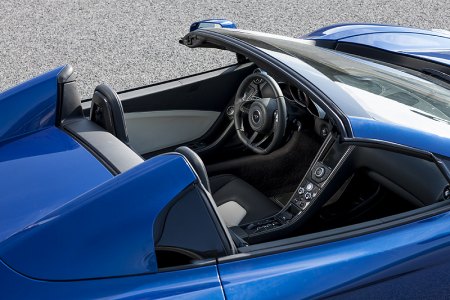
|
Aesthetically, the conversion to open top is quite
successful. A pair of flying buttresses (like the 458 Spider) standing
freely from the engine lid and reminds you the company's connection to
Formula One. They double as roll-over bars to protect the cabin. Also
like the Ferrari, a vertical glass rear window can be raised by the
press of a button to reduce buffeting and noise. Nevertheless, the wind
management on McLaren is less effective than the Ferrari's. At 80 mph
on motorway, the buffeting is well beyond acceptable level, while wind
noise is so loud that you have to raise your voice to talk with the
blondie beside.
The 2-piece folding roof is made of sheet molding composites just like
the rest of the body shell. It can be stowed behind the cabin in 17
seconds. When the roof is up, an extra luggage space is revealed and
you can place a pair of custom bags.
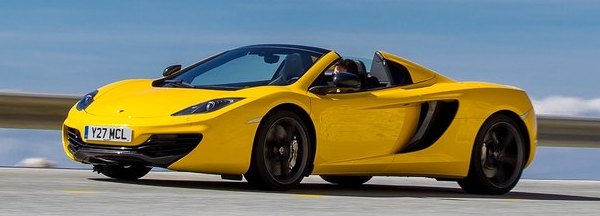
|
On the road, the 40 kg extra weight can hardly be felt. The
car accelerates, rides, handles and steers just as brilliant as the
Coupe because it shares the same chassis rigidity and suspension
setting. Moreover, like the Coupe, it gets the latest ECU mapping
upgrade to promote the sense of emotion – something used to be its
biggest weakness. Now the power delivery is a little bit more urgent at
the last 1000 rpm. Peak output is lifted by 25 horsepower at 500 rpm
higher the rev. The gearshift becomes a little quicker and crisper at
Sport and Track mode, while auto mode sees a bit more smoothness than
before. Sound quality is also improved – louder, angrier and more
brutal, though the sound quality is still no match with Ferrari's
high-revving naturally aspirated V8.
With a top speed of 204 mph and 0-60 acceleration of 3.0 seconds, this
could be seen as the ultimate open-top supercar unless you can afford a
Bugatti Veyron Grand Sport. Its performance and handling are superior
to its closest Ferrari rival. However, 458 Spider still offers a sexier
look, tighter panel fit, more aural excitement as well as a better
engineered roof. While it might lose to the McLaren in a number of
essential objective areas, it is still the most desirable choice.
|
Verdict:      |
| Published
on 9
Apr
2014 |
All rights reserved.
|
|
650S
|
|

|
With 1300 units sold last
year, MP4-12C has been quite a success. No doubt a large part of it
comes at the expense of Ferrari and Aston Martin. This explains why
Aston has been troubling by sales decline recently while Ferrari made
an unexpected announcement about stop chasing for volume. However,
McLaren cannot afford to take a rest at this moment. The 12C is still
trailing 458 Italia in a number of key areas, let alone the newer 458
Speciale, which is a sizable leap again. A lot can be improved upon the
12C, in particular its ungainly front-end styling, non-linear brake
feel and the general feeling of lacking sharp responses compared with
Ferrari. Moreover, Woking has learnt a lot how to tune the chassis and
engine in the development of P1 and these know-hows can feed back to
the production car. Consequently, the 12C has received an early
modification and evolved into 650S.
The name 650S implies its new found power – now a class-leading 650 hp,
50 ponies more than the original 12C or 25 more than the 2012 tweak.
However, its modifications are far broader than that. In fact, some 25
percent of all components have been changed in the update. First of
all, its whole front-end has been restyled with reference to P1. It
definitely looks more stylish than the old car, if still lacking the
classy finish of Ferrari and Aston. Like P1, its new
headlamps have added LED stripe lights to look fancier. The center
section of the front bonnet is set deeper, promoting the now-curvier
flanks and improves the aesthetic a lot. At the side, the only change
is the large air intake, which gets a carbon-fiber trap cover which not
only looks more purposeful but also increases airflow to cool the
engine. McLaren did not touch the rear end as it considered that to
look fresh enough. Overall, the new body generates 40 percent more down
force at 150 mph, now totalling 100 kg.
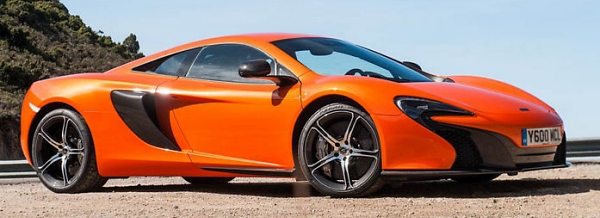
|
To enable the increased power, the Ricardo M838T twin-turbo
V8 gets lighter pistons, re-ported cylinder heads, revised cam
profiles, larger exhaust valves, re-mapped ECU and an exhaust system
with reduced backpressure. Peak torque increases from 442 to 500 lbft,
allowing the McLaren to extend its performance advantage over rivals –
0-60 mph now drops to only 2.9 seconds, while 0-100 mph can be done in
a staggering 5.7 seconds, a full second clear of 458 Italia! This car
offers performance remarkably close to those million-dollar supercars.
In the subjective side, the new car’s exhaust note is benefited by the
revised ECU, which retards ignition on upshifts to produce a more
aggressive blat-blat noise. Meanwhile, revised gearbox program makes
the gearshift a tad smoother at low speed. Both aspects inch closer to
the territory of Ferrari.
McLaren also rethought its suspension tuning. Front and rear springs
have been stiffened by 22 and 37 percent respectively, while
recalibrated hydraulic system (Proactive Chassis Control) and lighter
forged alloy wheels largely compensate the loss of low-speed ride
comfort. For a high-performance sports car, the McLaren is still
remarkably comfortable to drive at leisure pace. Drive harder, you will
appreciate the added alertness the stiffer suspension brings. Turn-in
gets quicker and the steering responses sharper, if not ultimately as
direct as Ferrari’s. Pirelli P-Zero Corsa tires now come standard and
its compound is specially revised for the 650S to generate more grip.
Likewise, carbon-ceramic brakes become standard fitment. Its pedal feel
has been much improved, giving a far more progressive response. The
harder you push, the better the car goes. The recalibrated ABS, ESP and
Brake Steer intrude less in Track mode and give you a wider scope to
exploit the chassis. The lack of active differential no longer seems to
be an issue.
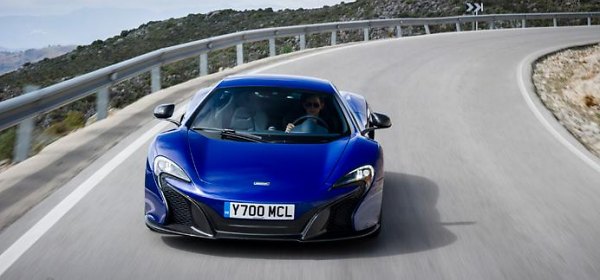 |
Is it as good as 458 Speciale? I suppose the latter still
has an edge in a number of areas, such as an instantaneous throttle
response from its naturally aspirated motor, a more aggressive exhaust
note, a slightly faster gearchange, a bit quicker steering and probably
a more beautiful control of power slide through its Side Slip Control.
It is also more beautiful to look, feels more special (especially
inside the cockpit and the engine compartment) and more precise in
build quality. The 650S strikes back with its stronger performance and
a slightly lower price tag at £195,000, even though it is already
an increase of £20,000 over its predecessor. Both cars can be
considered as winners in the eyes of car enthusiasts. That is probably
the worst news to Aston.
|
Verdict:      |
| Published
on 7
Aug
2015 |
All rights reserved.
|
|
675LT
|
|
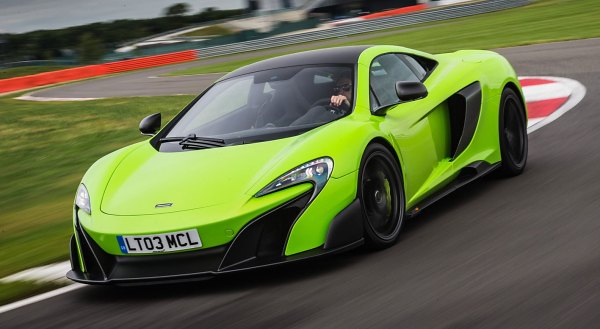
|
When the original McLaren
MP4-12C was introduced 4 years ago, it wasn’t quite perfect. No matter
engine, handling or styling, it lived under the shadow of Ferrari 458.
However, like a raw diamond, it had potential to be great. In Formula
One fashion, McLaren learnt quickly, sharpening its techniques and
sorting out the problems one by one. When 650S arrived, it was almost a
match to the Ferrari. Unfortunately, by that time Ferrari had already
upped its game with 458 Speciale, which was (and probably still is) the
most thrilling sports car ever existed. It took McLaren nearly 2 years
to respond, and the result is 675LT.
Ridiculously, when the 675LT arrives, Speciale is already gone.
Ferrari’s latest weapon is the turbocharged 488GTB. Although merely 5
horsepower separating the new Ferrari and McLaren, they are not direct
rivals. The Ferrari is a standard production car designed primarily for
road use, whereas the 675LT is a stripped-out edition oriented to
tracks, just like the late Speciale. Its production is limited to 500
units. At £260,000, it is an eye-popping 40 percent more
expensive than the 488, or 25 percent more than what Speciale asked
for. It is unusual that a McLaren dares to charge more than the
equivalent Ferrari. Considering its less sexy looks, lower perceived
quality and a less prestigious badge, it had better to be great to
drive…
The name 675LT refers to its horsepower count and “Long Tail”, the
latter is a gimmick I would say. While the original Longtails, the 1997
McLaren F1 GTR race car and F1 GT road car, sported a massively
extended tail to increase downforce, the 675LT is only 37 mm longer
than the 650S, and that already includes the longer front splitter!
From these pictures, it is really hard to tell whether its tail is
longer. However, more obvious to our eyes is lower. Its front
suspension is lowered by 20 mm, pushing the massive front splitter
closer to the ground (note: so low that it needs a front lift system to
avoid scratching the nose on B-roads). This also increases the rake
angle of the whole car to increase downforce. Same goes for the 50
percent larger rear spoiler (aka "Air Brake") and larger side skirts.
The
front and rear tracks are extended by 20 mm, and now they are housed
under fenders made of carbon-fiber instead of glass-fiber.
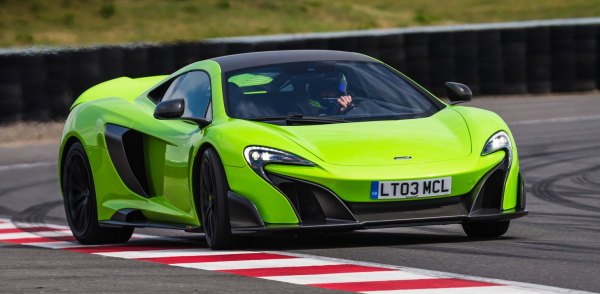
|
In fact, the front bumper as well as the entire body work
aft of the B-pillars are also made of carbon-fiber. Weight saving is
crucial to track specials like this. The 675LT is 100 kg lighter than
the 650S. At 1328 kg with fuel and fluid on board, it is extremely
light these days, especially for one possessing nearly 700 horsepower.
It goes without saying the carbon-fiber Monocell tub is a good starting
point,
but the 675LT needs also to take an extensive diet to lose weight, such
as using thinner windscreen, polycarbonate rear screen, a 10 kg lighter
engine, titanium exhaust, lighter wheels, and of course the stripped
out interior. In standard guise it has the air-con discarded to save a
valuable 11 kg, though you can opt it back free of charge. The
carbon-fiber racing buckets (taken straight from P1) save another 15
kg. Alcantara trim shaves 3.5 kg over leather.
Changes to the M838TL engine is more extensive than the numbers
suggested. McLaren claims more than half the components are new, and
some come from the P1. The new connecting rods are 11% lighter to
enhance enthusiasm for rev (though max rev remains at 8500 rpm). The
turbos are the same size, but they get new
compressor turbines machined from a solid block of aluminum to optimize
weight, strength and flow (though Ferrari’s titanium turbines are
undoubtedly lighter). The turbo wastegates are now controlled by
electronics rather than mechanicals. The new titanium exhaust reduces
back pressure. The camshafts, cylinder heads, exhaust manifolds and
fuel injection have all been revised. Besides, the side radiators are
now better cooled by larger side intakes. The outcome is 675 hp and 516
lbft of torque, versus 650 hp and 500 lbft on the 650S.
Modest gain that might sound, in the real world the new V8 feels quite
a lot stronger. It revs faster and keener especially at the upper half
of its rev range, thanks to the reduced inertia as well as the faster
gearshift. In the most aggressive mode, the engine now cuts ignition
instead of fuel on upshift. Once the ignition is resumed, it can get
back to power almost immediately as fuel is already sprayed into the
combustion
chambers. The resulting upshift can be brutal but exciting, as the
acceleration is really terrifying – it takes only 2.8 seconds from 0-60
mph, and 7.9 seconds to 124 mph, 0.1 and 0.4 second respectively faster
than 488GTB! Another benefit is additional pops and crackles on
overrun, as unburned fuel ignites at the downstream exhaust system.
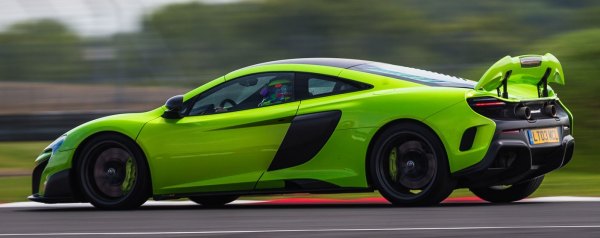
|
That said, the Ricardo-built V8 is never a model for sound
quality. Even though it shouts louder in the thinly insulated 675LT,
the
soundtrack is more industrial than emotional. Likewise is the power
delivery. Compared with the very best turbo motor of 488GTB, it
lacks the almost lag-free low-down response and the superb linearity
over the entire rev range. It feels more boosty, more conventionally
turbocharged, although not as obvious as 650S because its top end is
keener. The full boost at around 4500 rpm might bring more drama than
Ferrari's regulated mid-range, but for road use it is definitely not as
desirable. Of course,
we still miss the normally aspirated V8 of Speciale, whose sound and
throttle
response are on another league again.
Like 488GTB, the 675LT is so fast that it could be insane for road use.
It needs a race track to exploit its incredible performance. Here, its
chassis upgrade shines. The semi-slick Pirelli P Zero Trofeo R rubbers
generate 6 percent more grip than those of the 650S, at least on dry
surfaces. The stiffer suspension setup, with spring rates increased by
27% up front and 63% at the rear axle, results in even flatter
cornering and braking. The modified aero kits bring 40% more downforce,
which helps pressing the car on the track at high-speed bends. This is
a car you can push incredibly hard on track with full trust!
What’s more impressive is the steering. Its steering rack ratio is 10%
quicker than that of the 650S. This gives it a sharp turn-in that the
650S lacks. Meanwhile, its extra weight gives a more reassuring feel
than the light yet ultra-fast steering of Ferrari. The car is better
balanced than before, too. The combination of wider front track and
extra front-end grip means it is no longer default to understeer like
650S. It stays neutral as you push it deep into corner, and then it is
happy to shift to oversteer should you plant the throttle pedal or
flick the steering. This extra adjustability and playfulness gives you
a lot more fun than you can achieve in the 650S. Ultimately, however,
McLaren’s reliance on Brake Steer instead of a true active differential
means you can’t quite hold the powerslide as precisely as the
SSC-enabled Ferrari.
How about its behavior on normal roads? Sure, the low-speed ride is
stiffer than 650S, but in the softest setting it is still capable to
cover B-roads without causing back pain. As speed rises, its ride
improves further, becoming flat and composed. The hydraulically
interconnected adaptive suspensions (aka "Proactive Chassis Control")
still has an edge over conventional adaptive dampers. This allows the
675LT to be used as a cross-country weapon better than track specials
have any rights to be. In fact, the cockpit is influenced more by the
added vibration from the carbon-fiber seats, the louder engine and
extra tire roar. Use it purely on road, Ferrari 488 or F12 makes more
sense. As a track-day weapon, no doubt the McLaren is superior, even
though I think the late 458 Speciale could be more thrilling still.
|
Verdict:      |
|
|
|
|
|
|
|
|
|
|
MP4-12C
|
2011
|
| Mid-engined,
RWD |
Carbon-fiber
tub, aluminum
subframes |
| Aluminum, glass-fiber |
| 4509 / 1908 / 1199 mm |
| 2670 mm |
V8, 90-degree
|
| 3799 cc |
DOHC 32 valves, DVVT
|
| Twin-turbo |
| - |
600 hp / 7000 rpm
|
442 lbft / 3000-7000 rpm
|
7-speed twin-clutch
|
F: double-wishbones
R: double-wishbones |
Hydraulic interconnected
adaptive dampers |
F: 235/35ZR19
R: 305/30ZR20
|
| 1336 kg dry / 1434 kg kerb |
| 205 mph (c) |
3.2 (c) / 3.3* / 2.9** / 3.2*** /
3.0****
|
6.7* / 6.1** / 6.7*** / 6.4****
|
9.1 (c)
|
15.3* /
13.9**
|
|
MP4-12C
|
2012
|
| Mid-engined,
RWD |
Carbon-fiber
tub, aluminum
subframes |
| Aluminum, glass-fiber |
| 4509 / 1908 / 1199 mm |
| 2670 mm |
V8, 90-degree
|
| 3799 cc |
DOHC 32 valves, DVVT
|
| Twin-turbo |
| - |
625 hp / 7500 rpm
|
442 lbft / 3000-7000 rpm
|
7-speed twin-clutch
|
F: double-wishbones
R: double-wishbones |
Hydraulic interconnected
adaptive dampers |
F: 235/35ZR19
R: 305/30ZR20
|
| 1336 kg dry / 1434 kg kerb |
| 207 mph (c) |
3.0 (c)
|
6.0 (c)
|
8.8 (c)
|
-
|
|
MP4-12C Spider
|
2012
|
| Mid-engined,
RWD |
Carbon-fiber
tub, aluminum
subframes |
| Aluminum, glass-fiber |
| 4507 / 1909 / 1199 mm |
| 2670 mm |
V8, 90-degree
|
| 3799 cc |
DOHC 32 valves, DVVT
|
| Twin-turbo |
| - |
625 hp / 7500 rpm
|
442 lbft / 3000-7000 rpm
|
7-speed twin-clutch
|
F: double-wishbones
R: double-wishbones |
Hydraulic interconnected
adaptive dampers |
F: 235/35ZR19
R: 305/30ZR20
|
| 1376 kg dry / 1474 kg kerb |
| 204 mph (c) |
3.0 (c) / 3.4*
|
7.2*
|
9.0 (c)
|
-
|
|
|
|
|
|
Performance
tested by: *Autocar, **C&D, ***MT, ****R&T
|
|
|
|
|
|
|
650S
|
2014
|
| Mid-engined,
RWD |
Carbon-fiber
tub, aluminum
subframes |
Aluminum, glass-fiber
|
| 4509 / 1908 / 1199 mm |
| 2670 mm |
V8, 90-degree
|
| 3799 cc |
DOHC 32 valves, DVVT
|
| Twin-turbo |
| - |
650 hp / 7250 rpm
|
500 lbft / 6000 rpm
|
7-speed twin-clutch
|
F: double-wishbones
R: double-wishbones |
Hydraulic interconnected
adaptive dampers |
F: 235/35ZR19
R: 305/30ZR20
|
| 1330 kg dry / 1428 kg kerb |
| 207 mph (c) |
2.9 (c) / 2.7***
|
5.7 (c) / 5.8***
|
8.4 (c)
|
13.2***
|
|
650S Spider
|
2014
|
| Mid-engined,
RWD |
Carbon-fiber
tub, aluminum
subframes |
Aluminum, glass-fiber
|
| 4509 / 1908 / 1203 mm |
| 2670 mm |
V8, 90-degree
|
| 3799 cc |
DOHC 32 valves, DVVT
|
| Twin-turbo |
| - |
650 hp / 7250 rpm
|
500 lbft / 6000 rpm
|
7-speed twin-clutch
|
F: double-wishbones
R: double-wishbones |
Hydraulic interconnected
adaptive dampers |
F: 235/35ZR19
R: 305/30ZR20
|
| 1370 kg dry / 1468 kg kerb |
| 204 mph (c) |
2.9 (c) / 3.0* / 2.8** / 3.2****
|
5.8 (c) / 5.8** / 6.3****
|
8.6 (c)
/ 8.7*
|
13.2** /
13.9****
|
|
675LT
|
2015
|
| Mid-engined,
RWD |
Carbon-fiber
tub, aluminum
subframes |
Carbon-fiber, aluminum
|
| 4546 / 1908 / 1188 mm |
| 2670 mm |
V8, 90-degree
|
| 3799 cc |
DOHC 32 valves, DVVT
|
| Twin-turbo |
| - |
675 hp / 7100 rpm
|
516 lbft / 5500-6500 rpm
|
7-speed twin-clutch
|
F: double-wishbones
R: double-wishbones |
Hydraulic interconnected
adaptive dampers |
F: 235/35ZR19
R: 305/30ZR20
|
| 1230 kg dry / 1328 kg kerb |
| 205 mph (c) |
2.8 (c) / 2.9*
|
5.5 (c) / 5.6*
|
7.9 (c)
/ 8.0*
|
-
|
|
|
|
|
|
Performance tested by: *Sport Auto,
**C&D, ***R&T, ****Autocar
|
|
|
|
|
|
|
|
|
Copyright©
1997-2015
by Mark Wan @ AutoZine
|
|